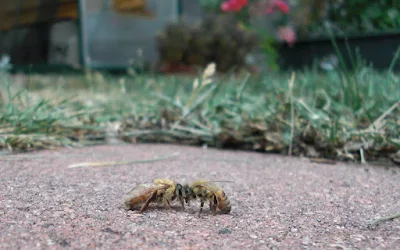Both of these bees have imperfect wings (not visible from this angle) and were probably airlifted then dropped this short distance from the hive. The worker bee has two varroa mites on her, the likely cause of her deformed wing. Since she can't fly back home, I guess the colony decided to evict her and her passengers, rather than groom the mites off.
Our second effort at drone culling didn't go so well; there weren't any drone cells on the combs we selected and both of us ended up getting stung. So we're letting go of the idea that we can use this method to manage varroa for the bees. For now, we're embracing the philosophy that if the colony is unable to deal with the mites on their own, then they have genetics that should be let go. Time will tell, but we feel confident in our colony. They've been displaying hygienic behavior, such as pupae with mites being rejected, and mites being thrown outside the hive, so it seems they've got good genetics. If they overwinter and swarm next year, we won't try to catch them. For the greater good of the world around us, we'll simply let them go.
Our second effort at drone culling didn't go so well; there weren't any drone cells on the combs we selected and both of us ended up getting stung. So we're letting go of the idea that we can use this method to manage varroa for the bees. For now, we're embracing the philosophy that if the colony is unable to deal with the mites on their own, then they have genetics that should be let go. Time will tell, but we feel confident in our colony. They've been displaying hygienic behavior, such as pupae with mites being rejected, and mites being thrown outside the hive, so it seems they've got good genetics. If they overwinter and swarm next year, we won't try to catch them. For the greater good of the world around us, we'll simply let them go.

0 comments:
Post a Comment
Join the Conversation. Leave a comment.